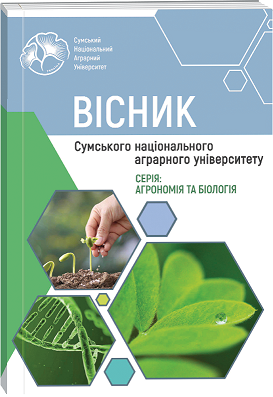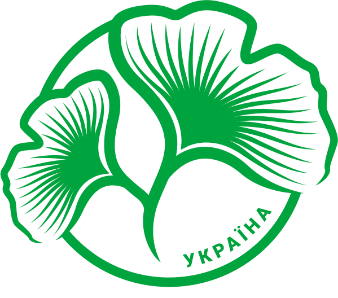CURRENT STATE OF BIODIVERSITY OF THE REGIONAL LANDSCAPE PARK «YALIVSHCHYNA» AND PROBLEMS OF ITS CONSERVATION
Abstract
Biodiversity is a key indicator of the value of a natural area, its conservation status and role in the conservation of certain species. Rare species are classified into three main categories: national, international and regional significance and protection. According to this gradation, the status of species is determined and their inclusion in the relevant lists and inventories, such as annexes to international conventions on the protection of flora and fauna, the Red Book of Ukraine and regional lists of species protected within the administrative regions. Biodiversity conservation is one of the most pressing problems of our time. The implementation of directives and environmental protection measures aimed at preserving biodiversity is becoming increasingly difficult, and in some cases impossible, due to the impact of military operations. The objects of the nature reserve fund occupy an important place on the map of Ukraine, since the main part of the country’s flora and fauna, which is under special protection at the state, regional and international levels, is concentrated here. The research was carried out during 2015–2024 on the territory of the regional landscape park «Yalivshchyna» within the city of Chernihiv. Based on the analysis of literary sources, the key characteristics of the biodiversity of the nature reserve fund object and adjacent territories were determined. In the process of analyzing the state of biodiversity, species protected at the regional, national and international levels were identified. The purpose of the research conducted on the territory of the regional landscape park «Yalivshchyna» in the city of Chernihiv was to clarify the current picture of the distribution of species of different categories and protection statuses in order to develop scientific recommendations for further protection, conservation and reproduction, as well as monitoring the state of their populations. Such comprehensive applied research is of great importance for the biodiversity monitoring system of nature reserve objects in individual regions, as they contribute to improving biodiversity protection at different levels (species, population, phytocenotic, ecosystem) and at different territorial levels (regional and state).
References
2. Andriienko, T. & Perehrym, M. (2012). Ofitsiini pereliky rehionalno ridkisnykh roslyn administratyvnykh terytorii Ukrainy [Official lists of regionally rare plants of the administrative territories of Ukraine]. Peregrym. Kyiv, 148. (in Ukrainian).
3. Antonelli, A. (2023). Five essentials for area-based biodiversity protection. Nature Ecology & Evolution. doi: 10.1038/s41559-023-02023-x (in English)
4. Bond, A., Pope,J., Morrison-Saunders, A., & Retief, F. (2021). Taking an environmental ethics perspective to understand what we should expect from EIA in terms of biodiversity protection. Environmental Impact Assessment Review, 86. doi: 10.1016/j.eiar.2020.106508
5. Carrasco, J., Mahaluf, R., Lison, F., Pais, C., Miranda, A., de la Barra, F., Palacios, D., & Weintraub, A. (2023). A firebreak placement model for optimizing biodiversity protection at landscape scale. Journal of Environmental Management, 342. doi: 10.1016/j.jenvman.2023.118087
6. Carrasco, L., Papeş, M., Sheldon, K. S., & Giam, X. (2021b). Global progress in incorporating climate adaptation into land protection for biodiversity since Aichi targets. Global Change Biology, 27(9). doi: 10.1111/gcb.15511
7. Chai, L., Liu, A., Li, X., Guo, Z., He, W., Huang, J., Bai, T., & Liu, J. (2024). Telecoupled impacts of the Russia–Ukraine war on global cropland expansion and biodiversity. Nature Sustainability. doi: 10.1038/s41893-024-01292-z
8. Chervona knyha Ukrainy. Holovna. (2024). [Red Book of Ukraine. Home]. (in Ukrainian). Access mode: https://redbook-ua.org/
9. Chervona knyha Ukrainy. Vsi tvaryny Chervonoi knyhy Ukrainy. (2024). [Red Book of Ukraine. All animals of the Red Book of Ukraine.] (in Ukrainian). Access mode: https://redbook-ua.org/animals/region/
10. Didukh, Ya. (2009). Chervona knyha Ukrainy. Roslynnyi svit. [Red Book of Ukraine. Flora] Hlobalkonsaltynh, 900. (in Ukrainian).
11. Ekardt, F., Günther, P., Hagemann, K., Garske, B., Heyl, K., & Weyland, R. (2023). Legally binding and ambitious biodiversity protection under the CBD, the global biodiversity framework, and human rights law. Environmental Sciences Europe, 35(1). doi: 10.1186/s12302-023-00786-5
12. Garside, A., Weir, D., & Plumptre, A. J. (2023). Protected zones in context: Exploring the complexity of armed conflicts and their impacts on the protection of biodiversity. International Review of the Red Cross, 105 (924), 1412–1440. doi: 10.1017/S1816383123000450
13. Hanson, T. (2018). Biodiversity conservation and armed conflict: a warfare ecology perspective. Annals of the New York Academy of Sciences, 1429(1), 50–65. doi: 10.1111/nyas.13689
14. Harper, M., Mejbel, H. S., Longert, D., Abell, R., Beard, T. D., Bennett, J. R., Carlson, S. M., Darwall, W., Dell, A., Domisch, S., Dudgeon, D., Freyhof, J., Harrison, I., Hughes, K. A., Jähnig, S. C., Jeschke, J. M., Lansdown, R., Lintermans, M., Lynch, A.J. & Cooke, S.J. (2021). Twenty five essential research questions to inform the protection and restoration of freshwater biodiversity. Aquatic Conservation: Marine and Freshwater Ecosystems, 31(9), 2632–2653. doi: 10.1002/aqc.3634
15. Hilborn, R., & Sinclair, A. R. E. (2021). Biodiversity protection in the 21st century needs intact habitat and protection from overexploitation whether inside or outside parks. Conservation Letters, 14(4). doi: 10.1111/conl.12830
16. Karger, D. N., Kessler, M., Lehnert, M., & Jetz, W. (2021). Limited protection and ongoing loss of tropical cloud forest biodiversity and ecosystems worldwide. Nature Ecology & Evolution, 5(6), 854–862. doi: 10.1038/s41559-021-01450-y
17. Karpenko, Yu. (2023). Rarytetne bioriznomanittia terytorii rehionalnoho landshaftnoho parku «Yalivshchyna»: struktura, poshyrennia ta pryntsypy okhorony [Rare biodiversity of the territory of the regional landscape park «Yalivshchyna»: structure, distribution and principles of protection]. Desna Polygraph, 128 (in Ukrainian).
18. Karpenko, Yu., Sverdlov, V., & Pototska, S. (2022). Florystychni ta tsenotychni osoblyvosti terytorii rehionalnoho landshaftnoho parku «Ialivshchyna» [Floristic and coenotic features of the territories of the regional landscape park “Yalivshchyna”]. Suchasni fitosozolohichni doslidzhennia v Ukraini: zbirnyk naukovykh prats z nahody vshanuvannia pamiati vydatnoho fitosozoloha, d-ra biol. nauk, prof. T.L. Andriienko-Maliuk (1938–2016 rr.). Kyiv, Talkom, 6, s. 38–44. (in Ukrainian)
19. Konventsiia pro okhoronu dykoi flory ta fauny i pryrodnykh seredovyshch isnuvannia v Yevropi, Konventsiia Rady Yevropy (1996) [Convention on the Conservation of Wild Fauna and Flora and Natural Habitats in Europe, Council of Europe Convention]. (in Ukrainian). Access mode: https://zakon.rada.gov.ua/laws/show/995_032#Text
20. Liu, C., Yang, J., & Yin, L. (2021). Progress, achievements and prospects of biodiversity protection in Yunnan Province. Biodiversity Science, 29(2), 200–211. doi: 10.17520/biods.2020082
21. Nurhidayah, L., & Alam,S. (2020). The forest and its biodiversity: assessing the adequacy of biodiversity protection laws in Indonesia. Asia Pacific Journal of Environmental Law, 23(2), 178–201. doi: 10.4337/apjel.2020.02.04
22. Palinchak, M. M., Diachenko, I. B., & Roshko, S. M. (2017). Klasyfikatsiia pryrodno-zapovidnykh terytorii ta obiektiv u konteksti konvetsii MSOP ta zakonodavchykh aktiv Ukrainy [Classification of Protected Areas and Objects in the Context of the IUCN Convention and Legislative Acts of Ukraine]. Naukovyi visnyk Uzhhorodskoho natsionalnoho universytetu, 16(2), 56–60 (in Ukrainian).
23. Panwar, R., Ober, H., & Pinkse, J. (2022). The uncomfortable relationship between business and biodiversity: Advancing research on business strategies for biodiversity protection. Business Strategy and the Environment. doi: 10.1002/bse.3139
24. Рarkhomenko, V., & Vasyliuk, O. (2022). Zapovidni terytoriyi i rosiysʹko-ukrayinsʹka viyna [Reserved territories and the russian-ukrainian war]. Suchasni fitosozolohichni doslidzhennia v Ukraini: zbirnyk naukovykh prats z nahody vshanuvannia pamiati vydatnoho fitosozoloha, d-ra biol. nauk, prof. T.L. Andriienko-Maliuk (1938–2016 rr.). Kyiv, Talkom, 6, 88–94 (in Ukrainian).
25. Pereira, P., Basic, F., Bogunovic, I., & Barcelo, D. (2022). Russian-Ukrainian war impacts the total environment. Science of The Total Environment. Scince of The Total Environment, 837, doi: 10.1016/j.scitotenv.2022.155865
26. Pro zatverdzhennya perelikiv vydiv tvaryn, shcho zanosyatʹsya do Chervonoyi knyhy Ukrayiny (tvarynnyy svit), tavydiv tvaryn, shcho vyklyucheni z Chervonoyi knyhy Ukrayiny (tvarynnyy svit). (2021). [On approval of lists of animal species included in the Red Book of Ukraine (fauna) and animal species excluded from the Red Book of Ukraine (fauna)]. Ofitsiynyy vebportal parlamentu Ukrayiny. (in Ukrainian). Access mode: https://zakon.rada.gov.ua/laws/show/z0260-21#Text
27. Rawtani, D., Gupta, G., Khatri, N., Rao, P. K., & Hussain, C. M. (2022). Environmental damages due to war in Ukraine: A perspective. Science of The Total Environment, 850. doi: 10.1016/j.scitotenv.2022.155865
28. Sousa, R., da Silva, J. P., Douda, K., & Mammola, S. (2022). The cost of war for biodiversity: a potential ecocide in Ukraine. Frontiers in Ecology and the Environment, 20(7), 394–396. doi: 10.1002/fee.2548
29. Vasyliuk, O., Shyriaieva, D., Kolmytsev, G., & Spinova, J. (2017). Steppe protected areas on the territory of Ukraine in the context of the armed conflict in the Donbas region and Russian annexation of the Crimean Peninsula. Bulletin of the Eurasian Dry Grassland Group, (33), 15–23. doi: 10.21570/edgg.bull.33.15-23
30. Von Jeetze, P. J., Weindl, I., Johnson, J. A., Borrelli, P., Panagos, P., Molina Bacca, E. J., Karstens, K., Humpenöder, F., Dietrich, J. P., Minoli, S., Müller, C., Lotze-Campen, H., & Popp, A. (2023). Projected landscape-scale repercussions of global action for climate and biodiversity protection. Nature Communications, 14(1). doi: 10.1038/s41467-023-38043-1
31. Westing, A. H. (1992). Protected Natural Areas and the Military. Environmental Conservation, 19(4), 343–348. doi: 10.1017/s0376892900031477
32. Woinarski, J. C. Z., McCormack, P. C., McDonald, J., Legge, S., Garnett, S. T., Wintle, B., & Rumpff, L. (2023). Making choices: prioritising the protection of biodiversity in wildfires. International Journal of Wildland Fire. doi: 10.1071/wf22229
33. Yadav, S. P. S., Adhikari, R., Bhatta, D., Poudel, A., Subedi, S., Shrestha, S., & Shrestha, J. (2023). Initiatives for biodiversity conservation and utilization in crop protection: A strategy for sustainable crop production. Biodiversity and Conservation. doi: 10.1007/s10531-023-02718-4
34. Yakubenko, B., Popovych, S., Ustymenko, P., Dubyna, D., & Churikov,A. (2018). Heobotanika: metodychni aspekty doslidzhen. [Geobotany: methodological aspects of research]. Lira, Kyiv, 348 (in Ukrainian).

 ISSN
ISSN  ISSN
ISSN 



